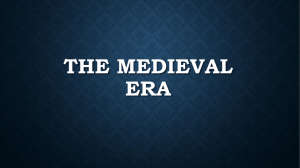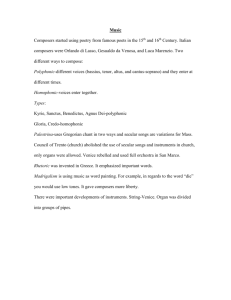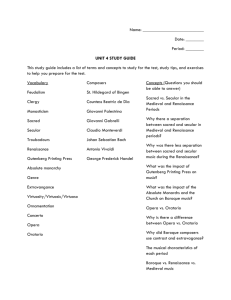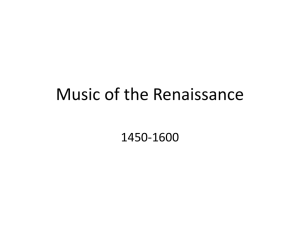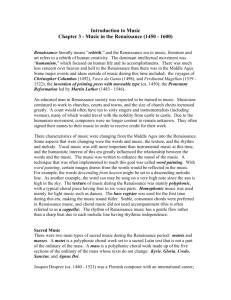Middle Ages - TeacherWeb
advertisement
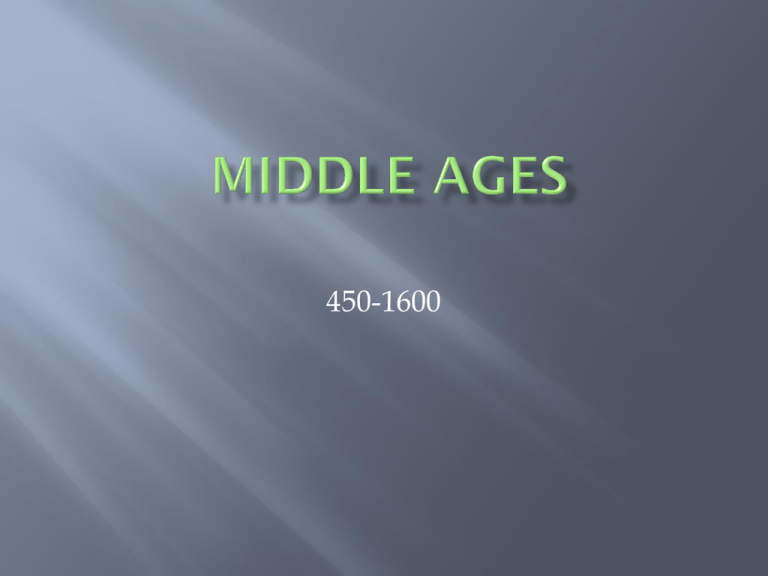
450-1600 Most important musicians were priests that worked for the church Boys received music education in schools, while girls were not allowed to sing in church but did make music in convents Most medieval music was vocal; instruments were used but were frowned on by the church After 1100, instruments were increasing in the church; the organ was most used (Could be heard for miles) Throughout the period the clergy complained about the noisy instruments Instruments were also the source of conflict between composers Official music of the Roman Catholic church for 1000 years Melody set to sacred Latin texts and sung without accompaniment Meant to emphasize specific parts of the religious service Named after Pope Gregory I (the Great) Most of the several thousand melodies known today were created between 600-1300 Most of the composers of these chants remain almost completely unknown Scales that consist of seven different tones and an 8th tone that duplicates the 1st an octave higher Used in secular and sacred music Alleluia: Vidimus Stellam (Listen) 1,48 A. Music outside of the church French nobles called troubadours and trouveres Knights also gained reputations as musical poets Love songs, crusades, dance songs, spinning Wandering minstrels- performed music and acrobatics in castles, taverns, and town squares Lowest in social level with prostitutes and slaves, but important source for information 1. 2. 3. Medieval dance and one of the earliest forms of instrumental music (Listen) 1,52 Instruments: Rebec- bowed string instrument Pipe- tubular wind instrument Psaltery- plucked or struck string instrument 700-900 first steps were taken that eventually transformed western music Monks began to add a second melodic line to the Gregorian chants Improvised in the beginning (not written down) Medieval music consisting of a Gregorian chant and 1 or more additional melodic lines is called organum. Hundred Years War Plaque (black death) Weakening of the Catholic church Secular music became more important than sacred music New system of music notation had evolved, composers could specify almost any rhythmic pattern Syncopation- rarely used before but very popular during this time Both a musician and a poet Known for the Notre Dame Mass – one of the finest compositions known from the Middle Ages The first polyphonic treatment of the mass ordinary by a known composer Mass ordinary- 5 sung prayers that remained the same from day to day throughout the church year Listen (Agnus Dei) 1,53 1450-1600 In keeping with the ideals of the era, every educated person was expected to be trained in music. Women were mostly virtuoso singers during this time especially in Italy in the late Renaissance Virtuoso- performing artist of extraordinary technical mastery Musicians during the Renaissance enjoyed higher pay and status Composers also wanted to be known and given credit for their work Italy- leading music center in the 16th century Others- Germany, England, and Spain Middle Ages- vocal music more important Renaissance- composers wrote music to enhance the meaning of the words Word painting- musical representation of specific poetic images Ex. Descending from heaven (descending melodic line), running (series of rapid notes) Mostly polyphonic Renaissance music sounds fuller than medieval music (bass register was used for the first time)= richer harmonies Unaccompanied choral music- a cappella 2 main forms: Motet and mass Motet- polyphonic choral work set to sacred Latin text (not ordinary mass) Mass- polyphonic choral composition made up of 5 sections: Kyrie, Gloria, Credo, Sanctus, and Agnus Dei Master of Renaissance music Compositions include masses, motets, and secular vocal pieces Ex. Ave Maria…Virgo Serena 1475 (Listen) 1,56 Became increasingly popular Development of music printing helped spread secular music and made thousands of songs available Every educated person was expected to play an instrument and read music Composers imitated natural sounds such as bird calls and street cries More rapid shifts of mood than sacred music A piece for several solo voices set to a short love poem Thomas Weelkes- among the finest English madrigalists Ex. As Vesta Was Descending (1601) written to honor Queen Elizabeth (Listen) 1,59 Popular instruments in the 1500’s: Harpsichord Organ Lute- versatile plucked string instrument with the body in the shape of a pear 1600’s instrumental music was written more for the instruments themselves and played for dancing and entertainment Every educated person was also expected to be skilled in dance Recorders Shawms Cornetts Sackbuts Lutes Violas Organs Regals Harpsichords
